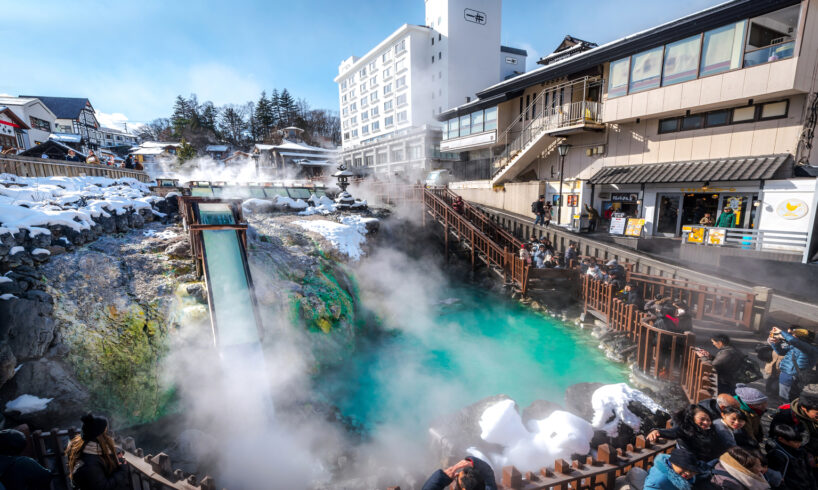
When temperatures dip and the air grows crisp, weekend escapes from Tokyo become all the more inviting. Whether you’re craving a classic onsen retreat, crisp mountain air or the chance to bask in local culture and winter illuminations, these destinations offer the perfect reset in the colder months.
List of Contents:
Botanical Pool Club, Chiba
Hakone, Kanagawa
Lake Kawaguchiko, Yamanashi
Echigo-Yuzawa, Niigata
Kusatsu Onsen, Gunma
Kamakura and Enoshima, Kanagawa
Karuizawa, Nagano
Izu Peninsula, Shizuoka
Kawagoe, Saitama
Jigokudani Snow Monkey Park, Nagano
Related Posts
Botanical Pool Club, Chiba
At first glance, the Botanical Pool Club may seem like a better summer getaway — it is, after all, a pool club. From November to March, however, the outdoor pool is kept at a cozy 40°C for a winter pool experience. Soak in steamy water while breathing in the crisp winter air and looking up at the stars above — an atmosphere that feels worlds away from Tokyo’s urban bustle despite being less than two hours away by bus or car.
Beyond the hot pool, the resort’s wellness offerings are great for fall and winter relaxation. Step into the sauna to warm up and unwind, then enjoy a comforting hot pot dinner featuring local, seasonal ingredients, as well as an array of season-limited warm cocktails.
Hakone, Kanagawa
Hakone is a cold-weather favorite for good reason: open-air hot springs, sweeping views of Mount Fuji and a cluster of attractions that are easy to explore in a single loop. The Hakone Round Course links the region’s famous ropeway, sightseeing bus and Lake Ashi “pirate ship” cruise into one scenic day trip.
Stop by Owakudani, home to dramatic sulfur vents and “black eggs,” a local specialty said to bring seven years of good luck to anyone who consumes one. Cap the day at the Hakone Open-Air Museum to witness sprawling sculptures with a mountainous backdrop. End your night with a soak in a rotenburo outdoor bath at a traditional ryokan.
Where to stay at Hakone
Gora Kadan: A prestigious ryokan built on the former site of an Imperial family villa, known for exceptional cuisine and beautiful gardens.
Hakone Kowakien Ten-yu: All rooms feature a private open-air onsen bath, perfect for ultimate privacy and relaxation.
Lake Kawaguchiko, Yamanashi
Few places bring you closer to Mount Fuji than Lake Kawaguchiko. Head to the Chureito Pagoda for the iconic view of Fuji juxtaposed with the spiritual site, ride the Mt. Fuji Panoramic Ropeway or join a lake boat tour for uninterrupted Fuji views next to beautiful swans. Warm up afterward with hearty Hoto noodles, the region’s beloved miso-based hot pot udon.
Where to stay at Lake Kawaguchiko
Fuji Lake Hotel: A highly-regarded hotel offering rooms and open-air baths with direct, magnificent views of Mount Fuji across the lake.
Konansou: A popular ryokan situated right on the shore of Lake Kawaguchiko. Many rooms also offer private baths with Fuji views.
Echigo-Yuzawa, Niigata
If you’re looking for a winter wonderland, Echigo-Yuzawa is one of the quickest snowy gateways from Tokyo. The shinkansen delivers you directly to Gala Yuzawa Ski Resort, where skiing, snowboarding and beginner-friendly snow sports are right at the station’s doorstep — all you have to do is get off at Gala Yuzawa Station. You can even rent gear on-site.
On the way, stop by Ponshukan, a sake tasting museum located right inside the station with vending machines that let you sample regional brews.
Kusatsu Onsen, Gunma
Known for having some of Japan’s most potent (read: sulfuric) hot spring water, Kusatsu is magical in fall and winter. Witness the Yubatake, the famed steaming hot-water field in the town’s center, and catch the lively yumomi performances, where attendants stir scalding spring water with wooden paddles.
Where to stay at Kusatsu Onsen
Tokinoniwa: A modern, elegant establishment, where every room includes a private open-air bath, as well as access to 23 public baths.
Kusatsu Onsen Boun: A traditional, long-established ryokan with serene garden baths near the Yubatake.
Kamakura and Enoshima, Kanagawa
Winter brings out a different side of Kamakura and Enoshima, with temple visits and seaside strolls cozier than ever — and fewer crowds than in the summer months. Visit the Great Buddha, wander the Tsurugaoka Hachimangu shrine and ride the scenic Enoden line along the coast. After sunset, the island of Enoshima lights up with the Jewel of Shonan illumination, one of the region’s most beautiful winter light displays.
Karuizawa, Nagano
With its refined resort town vibe, Karuizawa is ideal for a polished winter retreat. Ski or snowboard at Karuizawa Prince Snow Resort, shop at the designer outlets adjacent to the station or enjoy a quiet walk around Kumoba Pond, which is especially beautiful in late autumn as the autumnal leaves are reflected in the pond waters.
Izu Peninsula, Shizuoka
With a rugged coastline and mild climate, the Izu Peninsula is a treasure trove of cold-season destinations. Shuzenji Onsen is one of the most famous hot spring resorts in the area — not to mention one of the top 100 in Japan — known for its stunning scenery and peaceful bamboo grove. The picturesque seaside onsen town of Higashi Izu is also well worth a visit. In late February and early March, early-blooming Kawazu-zakura cherry blossoms bathe the area in soft pink ahead of the rest of Japan. Animal lovers should also pay a visit to Izu Shaboten Zoo to go look at the capybara soaking in outdoor hot springs.
Kawagoe, Saitama
Just 30 minutes by train from central Tokyo, Kawagoe is an atmospheric town full of Edo-period charm, filled with beautifully preserved buildings, local culture and traditional food. Explore the Kurazukuri warehouse district, which is lined with distinctive clay-walled buildings, listen for the chimes of the famous Toki no Kane bell tower and stroll through Kashiya Yokocho, a narrow lane famed for its nostalgic sweets.
Jigokudani Snow Monkey Park, Nagano
For a trademark Japanese winter trip, visit Jigokudani, where wild snow monkeys soak in natural hot springs from December to March, the coldest months of the year. The best way to get there is either by car or bus. From the parking lot, visitors must walk 30 minutes on an unpaved path to get to the actual park. The short hike to the valley adds to the experience, but make sure to wear appropriate clothes and footwear.
Related Posts
Discover Tokyo, Every Week
Get the city’s best stories, under-the-radar spots and exclusive invites delivered straight to your inbox.
Updated On November 20, 2025





